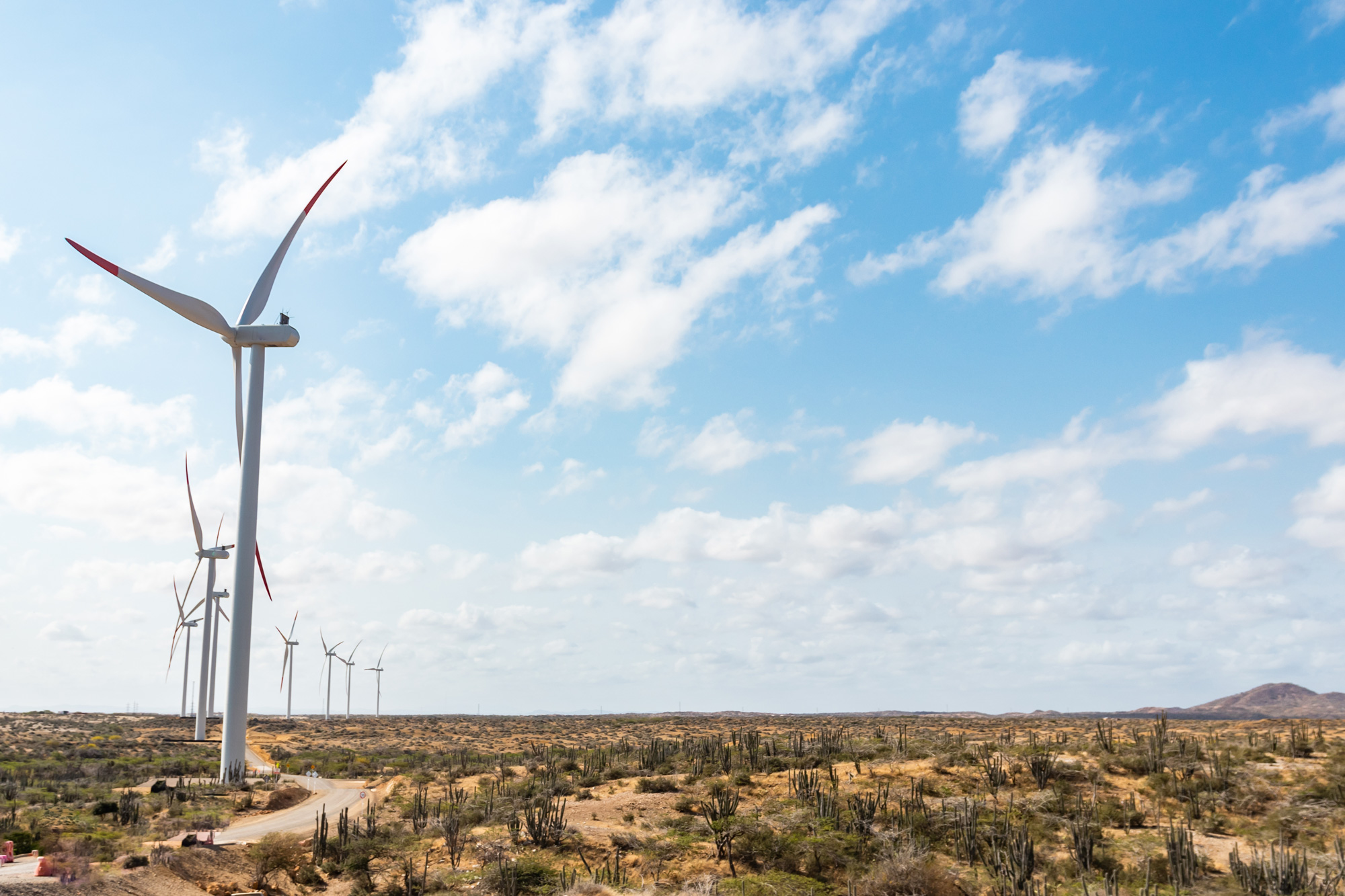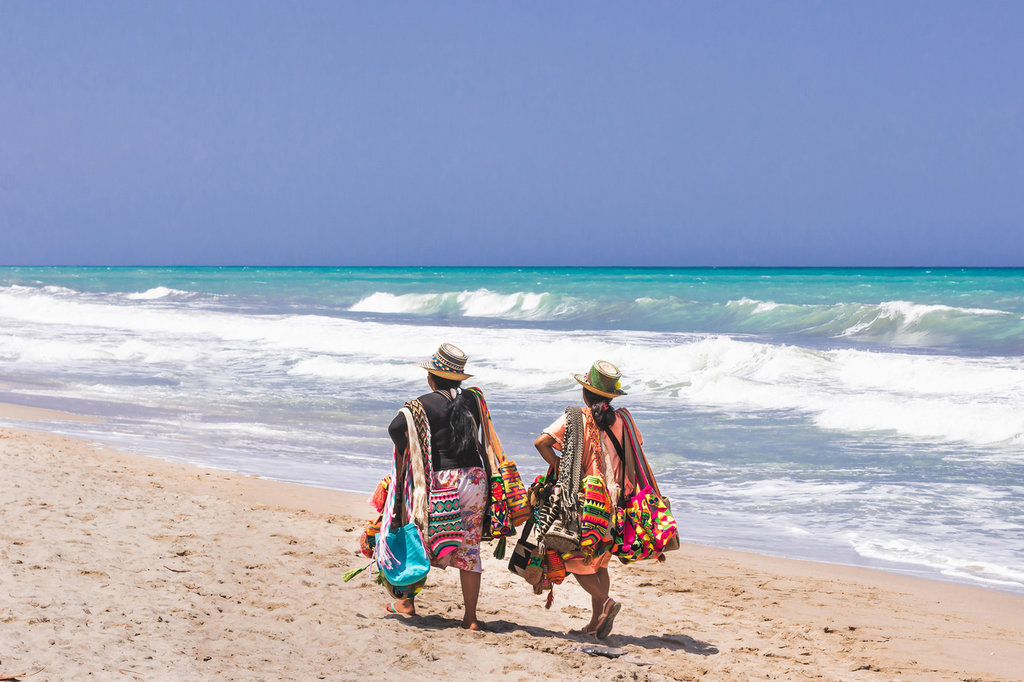Feature
La Guajira: The renewable centre tearing itself apart over wind
Despite its renewable promise, progress on wind projects in Colombia continues at a crawl. Alex Donaldson looks at the unintended consequences of development, and why one developer has pulled the plug.

Wind turbines in the Guajira Desert. Credit: GDCamelo via Shutterstock
Situated on Colombia’s Caribbean northern coastline, the department of La Guajira is an area that holds great potential for renewable energy generation. The onshore and offshore wind potential of La Guajira is enough to account for the nation’s energy demand multiple times over, courtesy of the country’s highest wind speeds.
As such, the region has seen investment in renewable power come from both near and far, most notably Italian energy generator Enel. However, Enel has failed to make headway into its La Guajira project, where it has been successful elsewhere in the country.
A lack of involvement with the department’s indigenous groups has been consistently cited as a major barrier for the larger proliferation of wind generation in the country’s best-placed region to do so. Now, however, there are serious risks of “capital flight”, where investment moves elsewhere, following the permanent suspension of Enel’s largest wind project in the nation. Despite the many benefits of the department’s renewable investments, the local populace are still at odds with multinational energy generators, leaving development at a standstill.
Enel, Windpeshi and the need for power
In Enel’s first quarter statements for 2023, the Windpeshi wind project was notably absent. The 205MW project was scheduled to begin energy generation in December 2022, but when May of 2023 rolled around, it remained only 35% complete. That month, the company announced the permanent suspension of the construction of Windpeshi. Enel now seeks, and continues to seek, a buyer for the project.
The project had been beset by protests from the Wayuu local indigenous community from the start. Whilst a seemingly isolated instance, the suspension of the project may well have dented Colombia’s renewable future.
Following the project’s abandonment, the department’s governor, Diala Wilches sent out a statement imploring Enel to stay. “La Guajira cannot miss the opportunity to become a clean energy development centre. On behalf of the Guajiro people, I ask Enel Colombia and the government, which are the parties involved in the contract, not to leave the department."
On behalf of the Guajiro people, I ask Enel not to leave the department
At 205MW, Windpeshi’s productive capacity would dwarf that of the 20MW Guajira I, the region’s largest completed project. But overall, La Guajira has the potential to generate as much as 18GW of power from wind alone, as much as twice the entire national demand for energy.
There are 16 wind projects currently under construction or in operation in La Guajira, of which many have been disrupted by Wayuu protests in a similar way to Windpeshi. No other department in Colombia has as many wind projects as La Guajira, nor has anywhere in the country matched the peak power generated by La Guajira. Still, there are barriers preventing from the region’s potential from being fulfilled.
The stake of the Wayuu People
Of La Guajira’s population, 48% are ethnic Wayuu, and ethnic Wayuu people experience the highest rates of poverty in the country. In June, Colombian President Gustavo Petro placed the province in a state of national emergency over a humanitarian crisis among the Wayuu. Despite its coastal location, La Guajira’s geography is mostly desert, and the vast majority of cases of malnutrition in the department come among Wayuu people. Obtaining food and water can be difficult, and shortages of both had worsened violence and corruption in the area...
Enel’s Windpeshi project promised to bring money and resources to the indigenous communities that it would affect. In February 2021, Enel Green Power inaugurated a system of public water fountains to provide clean water for over 3,000 members of the local community.
In the past people didn’t live by killing women for the profit of the wind power companies.
However, several Wayuu locals have alleged that Enel forcibly displaced residents in order to proceed with plans for the wind project. Enel Colombia denied this allegation, saying that it itself had no relation to any displacements or social issues in the area.
However, Enel’s intervention has reportedly, unintentionally, caused intra-community violence. Money handed out by the company has allegedly been the source of inter- and intra-communal extortion.
Leiji Hana González, a Wayuu woman displaced by violence in the area, told Diálogo Chino: “The wind farms have brought this greed to La Guajira. In the past people used to live off livestock […] we didn’t live by killing women for the profit of the wind power companies. They are generating money and doing some good things, but at the same time they’re hurting us, the Wayuu women.”

Wayuu women selling handmade bags. Credit: Saraponsphoto via Shutterstock
González explained that residents of her old village had received financial compensation from Enel Colombia as a result of the project’s location, but that other Wayuu clans had intimidated her and her family with the intention of causing her to leave, and then demanding further compensation for displacement from Enel. González added that the weapons the clansmen used for their intimidation tactics were purchased with money provided by Enel that they would not otherwise have had access to.
Enel supported the allegations of inter-clan violence, stating: “So far, as some media have commented, it has been estimated that this is a conflict between families,” though it added that the cases were in the midst of legal proceedings.
The future of wind power in La Guajira
In a visit to La Guajira in July, President Petro called for a resolution to the problems between the Wayuu and the energy companies operating in the department. Petro proposed a collaboration between both parties, with the Wayuu to be considered as allies of the clean energy projects.
The Colombian President stated that the current building processes has not succeeded as a result of little involvement with local communities. Petro proposed a permanent pact, establishing a partnership between the Wayuu and project stakeholders. The communities will, through this, see a continuous flow of profits from the projects that will hopefully ease the frictions.
Petro referenced the 2017 supreme court decision that upheld the rights of the Wayuu people against external threats, saying he will look to uphold the court’s ruling. There is, then, seemingly hope ahead for the Wayuu, but can the same be said for the outside energy investors looking in?
Enel, for its part, will attempt to continue operations in the region. Outside of the beleaguered Windpeshi project, the company still has two more wind projects in the country: Tumawind and Chemesky. With a combined 300MW of prospective power generation, these remain in development. Both, however, are even further behind in the development process than Windpeshi was at its closure.
All this means that sustained large-scale wind generation in the department is still a number of years away. Whether or not other companies will seek to invest in Colombia could be defined by Petro’s mediation between the energy companies and the Wayuu people. The renewable energy future of the region, and arguably the country, hangs in the balance.